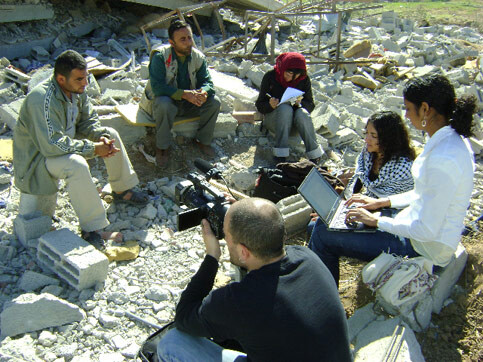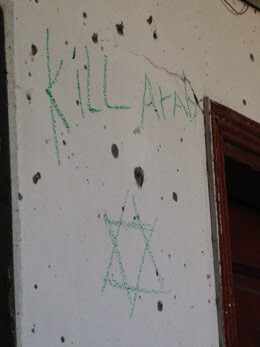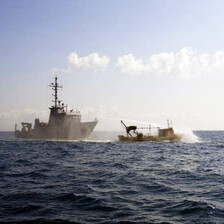Los Angeles, United States 20 March 2009

Huwaida Arraf, Radhika Sainath, with filmmaker Adam Shapiro, interview Khaled Abed Rabu outside his demolished home in eastern Jabaliya. (Mohamed Majdalawi)
Two days after Israel ended its 22-day invasion of the Gaza Strip, a friend and former clinical law professor in Jerusalem, Huwaida Arraf, asked me: “What do you think about organizing an emergency legal delegation to Gaza?” A small committee formed and we quickly put a call out for participants. Dozens of attorneys and law students from across the nation expressed their interest in traveling to Gaza to investigate the circumstances that led to massive Palestinian casualties, and to determine, what, if any, violations of international law occurred.
A week later, eight National Lawyers Guild members and a documentary filmmaker landed in Egypt. We crossed into Gaza through the Rafah land crossing on 2 February 2009. Minutes after Palestinian officials stamped our passports, we were startled by a loud explosion. “Don’t worry,” said one of the officials, unflinching. “They’re only bombing the tunnels. It’s normal here.” Though all of us had experience working or traveling in the Occupied Palestinian Territories (OPT), none of us were prepared for what we saw.
During our six days in Gaza, we visited neighborhoods in Gaza City, Jabaliya, Rafah and Khan Younis to interview paramedics, hospital workers, non-governmental organization representatives, Palestinian Ministry of Health officials and other civilian witnesses. In particular, we looked at three areas: (1) whether Israel targeted civilians or civilian infrastructure; (2) whether Israel had used weapons illegally; and (3) whether Israel had deliberately or arbitrarily blocked or prevented medical and humanitarian assistance to civilians during the offensive.
On our first evening, we met with John Ging, the Director of Gaza Operations for the UN agency for Palestine refugees (UNRWA). Ging told us how on 15 January 2009, Israeli forces hit the UN compound in Gaza City with white phosphorous shells. That morning, UN workers were in real-time communications with Israeli authorities, and informed them that more than 700 people had sought refuge in the compound from heavy shelling in the area. We saw the charred remains of UN warehouses containing food and medicine, and heard how UN workers retrieved fuel tanks to prevent them from exploding.
Throughout our week in Gaza, we recorded numerous accounts of Israeli soldiers shooting at civilians — who were often carrying white flags or attempting to flee — in violation of international law. Moreover, Additional Protocol I of the Fourth Geneva Convention requires that a belligerent give an effective warning when attacks may affect civilians.
Khaled Abed Rabu of eastern Jabaliya related how he witnessed an Israeli soldier kill his two-year-old and seven-year-old daughters in the early afternoon of 7 January 2009. “This is where it happened,” said Abed Rabu, sitting on the concrete remains of his home. Israeli soldiers had ordered the family out of the home, so his wife, mother, three daughters and he came out, holding four white flags amongst them. Two soldiers sat outside a tank, eating chips and chocolates, when a third, without warning, began shooting at the youngest, Amal. Abed Rabu looked down, and Amal’s stomach was outside her body. “She was carrying a white teddy bear, and the teddy bear was executed with her,” he said. When Abed Rabu bent down to pick her up, the soldier shot his seven-year-old, then his mother and his four-year-old daughter, who survived but is paralyzed.
As the soldier continued shooting, Abed Rabu ran back in the house carrying the surviving daughter, Samar, in his arms. After two hours of watching her bleed, Abed Rabu took Samar outside in his arms, believing the Israelis would shoot both of them, putting her out of her pain, and his as well. However, the soldiers let Abed Rabu and his family pass.
Abed Rabu walked for a kilometer when he reached an intersection. There, he saw Adham Hamis Naseer, with a cart and a white horse, coming to his aid. Israeli soldiers shot the horse in the head, and then Naseer, also in the head. It was this incident that made Abed Rabu incredulous — that they had shot a horse. That Israelis had set out to terrorize the entire population of Gaza, even going so far as murdering his children, was sadly not a surprise, but it was a surprise that they would take the life of a horse.

A Palestinian child walks outside tents setup for people whose homes were destroyed in Jabaliya, Gaza Strip. (Radhika Sainath)
During our week in Gaza, we also uncovered extensive evidence suggesting that Israeli forces destroyed buildings that had no links to militant or resistance activity.
In addition to attacks on UNRWA schools, Israeli forces also hit the American International School in Gaza — one of the Strip’s few co-ed schools. According to the school’s director, Dr. Ribhi Salem, the Israelis gave no warning nor targeted any areas adjoining the school. Dr. Salem also stated that not only had no armed resistance activity had ever taken place on the property, but Israel had never accused the school of harboring or being used by militants.
Israel also appears to have disregarded the prohibition on the use of indiscriminate weapons in civilian areas by using battlefield weaponry in heavily-populated civilian areas, namely white phosphorus, flechettes and artillery.
Dr. Nafiz Abu Shaaban, head of the burn unit at al-Shifa hospital in Gaza City, explained to us how that during the offensive, the hospital released patients with minor burns in order to clear beds for the large number of incoming victims. Many of those released returned a few days later, their wounds having expanded in size and depth. Doctors then realized that something was continuing to burn into the body following the initial treatment. It was not until two weeks into the Israeli offensive that foreign doctors, who had worked in Lebanon, identified the burns in Gaza as consistent with use of white phosphorous.
In addition to a belligerent’s duty to avoid injury to civilians, international humanitarian law requires that care be provided to the wounded. In conversations with medical workers and the families of victims, we documented many serious violations of the requirement to allow medical access to the injured.
For example, from 3-7 January 2009, the Palestine Red Crescent Society (PRCS) received 145 calls from the neighborhood of al-Zeitoun alone, but Israeli forces refused to allow ambulances to enter. “A lot of people could have been saved, but they weren’t given medical care by the Israelis, nor did the Israeli army allow Palestinian medical services in,” said Bashar Ahmed Murad, Director of Emergency Medical Services for PRCS. When the Israeli army finally allowed medics to enter on 7 January, they refused entrance of ambulances. Dr. Murad explained how paramedics were forced to “pile the wounded on donkey carts and have the medical workers pull the carts.”
When I left for Gaza, I, like many people, was aware of the stark disparity between Israeli and Palestinian casualties during the offensive that began on 27 December: the death toll currently stands at more than 1,400 Palestinians killed compared with 13 Israelis — three of whom were soldiers killed by friendly fire. Like many, I analyzed the Gaza attacks within the framework of “proportionality” — the idea that civilian injuries and deaths may not be excessive in relation to anticipated military advantage.

Graffiti by Israeli soldiers in a Palestinian home in the al-Zeitoun neighborhood of Gaza City. (Radhika Sainath)
Finally, the brutal killings of innocent civilians, whether by bombing neighborhoods or directly targeting people carrying white flags is never self-defense. These were not isolated incidents perpetrated by bad apples, but a repeated pattern of Israeli assaults on the dignity of Palestinians.
Israel’s 22-day assault on Gaza, and the horrors I witnessed, are consistent with Israeli General Moshe Yaalon’s aim that “The Palestinians must be made to understand in the deepest recesses of their consciousness that they are a defeated people.” Were this any other country, official sanctions and exclusion from the community of nations would be the obvious answer. More than two months have passed since the end of “Operation Cast Lead” and Gaza is still waiting for the world’s response. The question still looms: will Israel and Israeli war criminals ever be held accountable for the actions in a court of impartial international justice?
Radhika Sainath recently returned from a National Lawyers Guild delegation to Gaza. She practices civil rights law in Los Angeles, California.
Related Links


